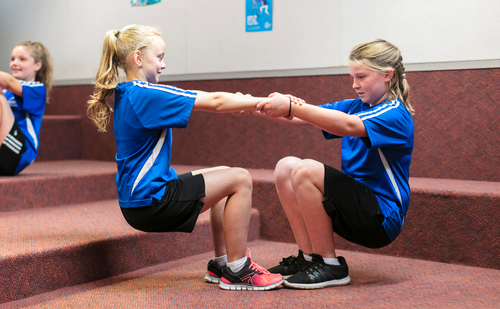Learning outcomes
Tamariki work collaboratively to problem solve and develop trust.
Tamariki work collaboratively to problem solve and develop trust.
This activity is a great combination of teamwork, problem solving, some physical effort and trust. It could be categorised as a light ‘trust’ exercise. Because the activity relies on the team, rather than being able to complete the task as individuals many skills are needed, including good communication, patience, understanding and determination. We also love that the pairs who generally master this game first aren’t always the ones who expect to!
Some tamariki may be concerned that during the back-to-back activity they may touch heads, as the upoko (head) is tapu. If this is a concern, you could try the face-to-face activity instead.
Let tamariki know this is an activity where:
But interestingly, all you’ll be doing is standing up and sitting down with the help of your partner. This is called a ‘Trust’ exercise. So it’s important you look after the people you’re working with and they’ll do the same for you. There is the potential for someone to get hurt in this activity, especially if we're not being trustworthy – so this is really important and a big part of the learning from this activity.
NB - strengths are referred to in this activity, so you may want to try the strengths activities first (though this isn't compulsory!).
Ask tamariki to pair up with someone who’s about the same height.
They will need to:

Let them work at this – it can be quite tricky despite seeming simple.
If after a few minutes they’re still struggling let them know that they’ll need to use each other’s feet as a firm base to push against, and lean away from each other (which seems counter-intuitive) using their weight to help pull them up. It's about 'balance'.
If some pairs succeed, ask them to try again until they feel really accomplished, or you may like to ask them to kindly coach others who are finding this exercise more challenging.
After about 10 minutes ask tamariki to freeze and debrief asking:
Ask tamariki to continue trying to get up, coaching each other and thinking about what strengths they can call upon to help.
If your class particularly love the challenge, they can then join as fours to see if this works (as a circle). Ask others to join – try 8. (NB: Physics will dictate that tamarki won’t be able to make this work beyond 8-10 people.)
When you feel the class is ready to move on, ask them to return to their pairs and:
This activity is more challenging than the first. One trick is to lean into each other’s backs and push your feet hard into the floor.
You might need to mix up the pairs after a time, to allow different tamariki to try together.
If pairs manage this activity, ask them to stand back-to-back, link their arms, and sit down together. Let them try it themselves, and if they struggle, mention that they’ll need to start by slowly walking their feet out, then lower into a squat position, while leaning against each other (i.e. the reverse of what they just did).
Ask these pairs to coach others in the room who are finding the activity challenging.
After about 5 – 10 minutes, ask tamariki to freeze and debrief by asking:

You can revisit this exercise anytime so tamariki have an opportunity to work with others, practice and join the larger mega-groups.
Try other Trust Activities such as:
This game is adapted from the book Silver Bullets by Karl Rohnke. Silver Bullets is filled with adventure based games and trust activities. If you’re working with older tamariki, this is a great resource for new ideas on play-based learning, encouraging benefits such as team work, building self confidence and taking the initiative.